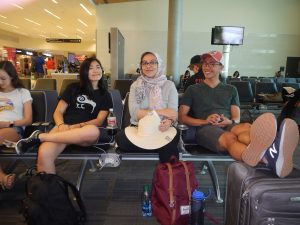Hi friends, I’m Veronica! Tomorrow, we go to Belize. Here are some thoughts.
I was an interesting sort of kid – I was quite socially awkward, listened only to classical music (my favorite composer was Bach. Who’s Rihanna anyway?), and I didn’t watch any of the classic Disney Channel TV shows. Most importantly, I was absolutely obsessed with Animal Planet’s show The Crocodile Hunter. The show’s host, Steve Irwin, was my childhood hero. I remember sitting in front of the TV with my little brother, both of us riveted, as Steve fearlessly wrangled wild creatures or snagged the tiniest critters for the camera to see.
My younger brother and I were more interested in tiny shore critters on Daytona Beach than we were in Disney World.
I think that my devotion to Mr. Irwin and his show planted in my brain a fascination with wild places and their inhabitants. This is why I’ve been all but vibrating with excitement for this trip for the last month or so. I’ve never had any experience with field research, in the tropics or elsewhere, so I’m not sure what to expect. But I’m guessing it’s going to involve equal amounts of sweat and labor as rewarding finds and learning. I’m ready for it! (I think? I’m pretty out of shape, so I’m not sure how well I’ll handle the physical activity…but my mind is ready so BRING IT ON.) This trip is probably going to involve a lot of physical discomfort and wistful thoughts of air conditioning. But I do expect to put in some sweat to learn things that I could never learn from a textbook! I’m tired of classrooms. I am incomprehensibly excited to learn how to locate different organisms in the field, or how to decipher forest sounds. I can’t wait to learn hands-on how ecologists gather their hard-earned data.
My preparation for the trip has been rather frantic. I’ve been scurrying all over town in the past couple of months to collect all the required equipment. I even bought a prescription snorkel mask so I can see underwater, which I’m SUPER pumped about! I’ve also pored over the required reading materials, spent hours upon hours researching microbial processes of coral reefs, and researched all I can about echinoderms (think starfish, sea urchins, sea cucumbers) and lepidopterans (butterflies and moths). And, of course, I’ve hyped myself up for the trip by watching nature documentaries. My only apprehensions lie in my complete inexperience. I can be clumsy. Combined with my utter un-fit-ness, I’m afraid that in my physically exhausted state, I’ll be a drag on the group. I hope that I can keep up with the pace of the trip. And, of course, I hope we don’t run into any grumpy peccaries (like wild pigs) or fer-de-lances (species of venomous snake).
What I want to accomplish most during this trip is to scratch that itch I’ve always had in the back of my mind to go venturing out into the wild, if only for a little bit. I also hope to learn about what field ecology entails and to gain intimate understanding of tropical and neotropical ecosystems. I want to find specimens of the echinoderms and lepidopterans I’ve researched. But I think my core excitement for this course stems from a simple place: the little kid inside me really, really wants to get out there and explore, just like Steve Irwin.
On that note, WE LEAVE TOMORROW?! Amazing.
Catch you all in Belize!









